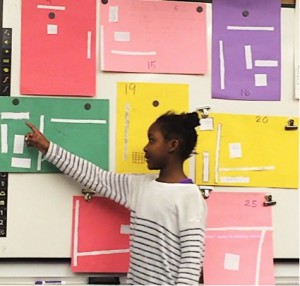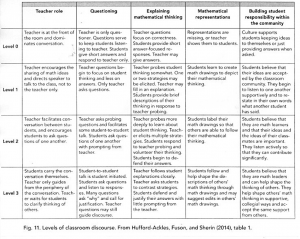Young mathematicians need to be able to “Construct viable arguments and critique the reasoning of others”, according to the National Council of Teachers of Mathematics. This philosophy aligns with LREI’s progressive educational goals of placing an emphasis on student voice, and creating a classroom culture of engaging student-to-student discussions. Students take on the role of leaders who believe that they can actively defend their own mathematical ideas, and help shape the ideas of their colleagues in a supportive, nurturing environment.
Among other teachers in the lower school, Elaine and Jessie have been making a conscious effort to engage their third grade students in this way. The topic was multiplication and using the array as a model. Take a look at a couple recent videos taken from their classrooms to see this in action, and read about how this evolving philosophy is shaping their practice.
– Debra Rawlins
Jessie’s class discussion from Debra on Vimeo.
Jessie, Third Grade LS teacher writes:
In an effort to better apply our progressive thinking to our math curriculum, we have begun to think about how to transfer the control of a math lesson from the teacher to the student; to promote student voice; to encourage both mathematical investigation and communication. Simply put, we are handing the pen over to the student. Each mathematical investigation is followed up with a class discussion. The teacher’s role is to carefully select specific examples of student work to get the discussion going. Pieces of work are chosen based on observation of and conversation with students during the investigation, and are selected in order to try to encourage students to think about specific concepts and strategies. Students who share are asked to present their thinking, and then call on their own classmates to respond with comments and questions. In this way, a presentation then becomes a circular discussion. As their classmates add on to their ideas, they are invited to come up and write their thinking on the board. During the discussion, the teacher’s role is to simply observe and occasionally jump in with a question or comment to further push students in their thinking.
In order to foster meaningful discussions, we have conversation with our students about the purpose and importance of these discussions: of sharing and communicating our thinking, of asking questions and restating each other’s ideas, and of listening to and learning from our classmates. We talk about speaking loudly and proudly, and how to gauge whether or not your classmates are understanding what you are saying. We encourage students to push themselves to share if they haven’t already, and to give others a chance if they have. We have also rearranged to the classroom to create a more comfortable space for student-led discussions. By clearing the space in front of the Elmo, there is now more room for students to get up in front of their classmates to talk and write on the board. Students are more comfortably spread out between the floor and chairs, so that everyone has a good view of the board and the ability to hear each other share. As a result of these conversations and environmental changes, students are developing both the skills and confidence needed to be successful communicators of mathematical thinking.
Elaine’s student discussion from Debra on Vimeo.
Elaine, Third Grade LS teacher writes:
Finding ways to give students more voice in the classroom is an ongoing challenge, no matter what the subject. Authenticity is key. In math, we have been trying out an approach that is still structured but allows students ownership and exploration of more open-ended mathematical concepts and questions. While part of this has to do with the type of problem(s) we present–trying to make them relevant, appropriately challenging with multiple entry points, and interesting–shifting the lesson so that students can present their thinking and give each other feedback has changed the culture of our math lessons. As students search for ways to articulate their thinking, it is sometimes a struggle for the teacher not to jump in and help clarify. But when students are asked to be thoughtful about each others’ work and ask questions about what they don’t understand, their participation is immediately more active. The discussions are still about sharing solutions and strategies, but the emphasis is on discovering the relationships between the various strategies and ideas, which inevitably leads to an exploration of important mathematical concepts such as what “multiplicity” means, why it may be easier to find arrays of even numbers over odd numbers, or the relationship between multiplication and division. Students who were quiet because “they were not good at math” have found their voice, and those who “got the answer quickly” are challenged to think about why the math works the way it does. Their noticings and questions and even assumptions lead to more questions–ones that examine inherent properties and phenomenon of numbers.
Here are some interesting quotes from research on student discourse in mathematics that appeared in Principles to Actions: Ensuring Mathematical Success for All (2014, NCTM):
Discourse that focuses on tasks that promote reasoning and problem solving is a primary mechanism for developing conceptual understanding and meaningful learning of mathematics. (Michaels, O’Connor, and Resnick, 2008).
Students who learn to articulate and justify their own mathematical ideas, reason through their own and others’ mathematical explanations, and provide a rationale for their answers develop a deep understanding that is critical to their future success in mathematics and related fields (Carpenter, Franke, and Levi, 2003).
Although discourse provides important opportunities for students to learn what mathematics is and how one does it, creating a culture of discourse in the mathematics classroom also presents challenges. Teachers must determine how to build on and honor student thinking while ensuring that the mathematical ideas at the heart of the lesson remain prominent in class discussion (Engle and Conant, 2002).
For example, in orchestrating a class discussion of student approaches to solving a task, the teacher must decide on what approaches to share, the order in which they should be shared, and the questions that will help students make connections among the different strategies and the key disciplinary ideas that are driving the lesson (NCTM, 2014).
Students must also have opportunities to talk with, respond to, and question one another as part of the discourse community, in ways that support the mathematics learning of all students in the class. Hufferd-Ackles, Fuson, and Sherin (2014) describe a framework for moving toward a classroom community centered on discourse. They examine how teachers and students proceed through levels in shifting from a classroom in which teachers play the leading role in pursuing student mathematical thinking to one in which they assist students in taking on important roles. The framework describes growth in five components:
- How the teacher supports student engagement
- Who serves as the questioner and what kinds of questions are posed
- Who provides what kinds of explanations
- How mathematical representations are used
- How much responsibility students share for the learning of their peers and themselves
Below is a table developed by Hufford-Ackles, Fuson, and Sherin to describe the levels of classroom discourse through which teachers and their students advance.


